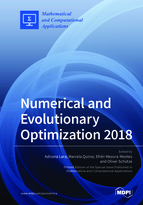Numerical and Evolutionary Optimization
A special issue of Mathematical and Computational Applications (ISSN 2297-8747). This special issue belongs to the section "Engineering".
Deadline for manuscript submissions: closed (31 July 2019) | Viewed by 41669
Special Issue Editors
Interests: multi-objective optimization; optimization; evolutionary computation; mathematical programming; memetic algorithms
Special Issues, Collections and Topics in MDPI journals
Interests: experimental algorithmics; metaheuristics; genetic algorithms; bin packing; machine learning; causal inference applications
Special Issues, Collections and Topics in MDPI journals
Interests: design and implementation of metaheuristics for optimization; applications of artificial intelligence; robotics and mechatronics
Special Issues, Collections and Topics in MDPI journals
Interests: multi-objective optimization; evolutionary computation (genetic algorithms and evolution strategies); numerical analysis; engineering applications
Special Issues, Collections and Topics in MDPI journals
Special Issue Information
Dear Colleagues,
The development of powerful search and optimization techniques is of great importance in science and engineering, particularly in today's world, which requires researchers and practitioners to tackle a variety of challenging real-world problems as technology becomes an ever-more-important aspect of everyday life. There are two well-established and widely-known fields that are addressing these issues: (i) traditional numerical optimization techniques and (ii) comparatively recent bio-inspired heuristics, such as evolutionary algorithms and genetic programming. Both of these fields have developed approaches with their unique strengths and weaknesses, allowing them to solve some challenging problems while sometimes failing in others.
Recent studies have shown that the consideration of elements coming from both fields can lead to great synergies, e.g., in understanding of certain algorithms or in the design of new search techniques.
The aim of this Special Issue is to collect papers on the intersection of numerical and evolutionary optimization. We strongly encourage the development of fast and reliable hybrid methods, that maximize the strengths and minimize the weaknesses of each underlying paradigm, while also being applicable to a broader class of problems. Moreover, this Special Issue fosters the understanding and adequate treatment of real-world problems, particularly in emerging fields that affect us all, such as health care, smart cities, and big data, among many others.
Topics of interest include (but are not limited to):
(A) Search and Optimization:
- Single- and multi-objective optimization
- Advances in evolutionary algorithms and genetic programming
- Hybrid and memetic algorithms
- Set oriented numerics
- Stochastic optimization
- Robust optimization
(B) Real World Problems:
- Health systems
- Computer vision and pattern recognition
- Energy conservation and prediction
- Modeling and control of real-world systems
- Smart cities
Dr. Adriana Lara
Dr. Marcela Quiroz
Dr. Efrén Mezura-Montes
Prof. Dr. Oliver Schütze
Guest Editors
Manuscript Submission Information
Manuscripts should be submitted online at www.mdpi.com by registering and logging in to this website. Once you are registered, click here to go to the submission form. Manuscripts can be submitted until the deadline. All submissions that pass pre-check are peer-reviewed. Accepted papers will be published continuously in the journal (as soon as accepted) and will be listed together on the special issue website. Research articles, review articles as well as short communications are invited. For planned papers, a title and short abstract (about 100 words) can be sent to the Editorial Office for announcement on this website.
Submitted manuscripts should not have been published previously, nor be under consideration for publication elsewhere (except conference proceedings papers). All manuscripts are thoroughly refereed through a single-blind peer-review process. A guide for authors and other relevant information for submission of manuscripts is available on the Instructions for Authors page. Mathematical and Computational Applications is an international peer-reviewed open access semimonthly journal published by MDPI.
Please visit the Instructions for Authors page before submitting a manuscript. The Article Processing Charge (APC) for publication in this open access journal is 1400 CHF (Swiss Francs). Submitted papers should be well formatted and use good English. Authors may use MDPI's English editing service prior to publication or during author revisions.









